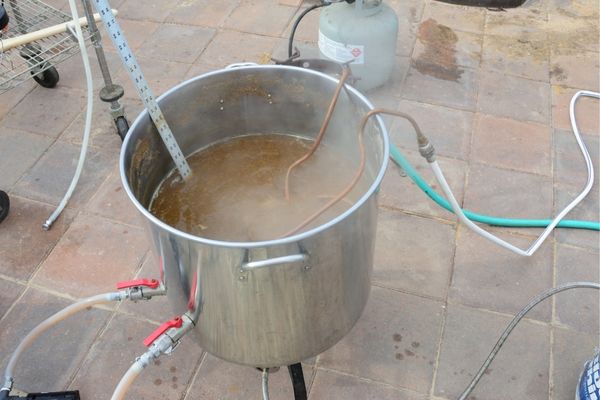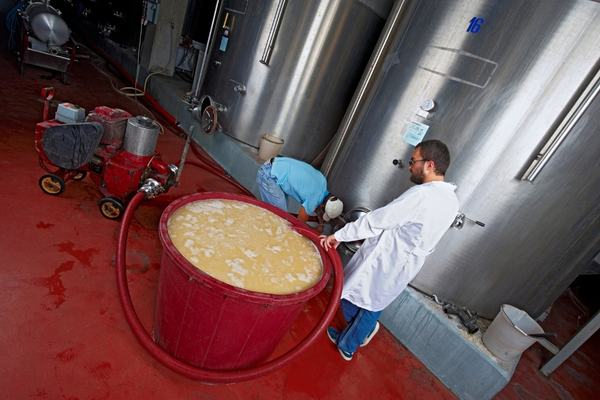If you’re a brewing enthusiast like me, you’ve probably heard of the term mash out. It’s one of the steps in the all-grain brewing process that some brewers swear by, while others choose to skip it.
But what exactly is a mash out and is it worth it in beer brewing?
In my experience, the answer is not a simple ‘yes’ or ‘no’. It depends on various factors such as your brewing equipment, the specific beer style you’re brewing, and your personal brewing philosophy.
In this blog post, I will explore the concept of mash out in detail and share my insights to help you decide if it’s worth it for your brewing process.
What is a Mash Out?
Mash out is the process of raising the temperature of the mash (the mixture of grains and water) to around 170°F (77°C) after the conversion of starches to sugars.

This is usually done before the sparging process, where the sweet wort is rinsed from the grains. The main objective of mash out is to stop enzymatic activity and make the grain bed more fluid for easier sparging.
The Science Behind Mash Out
The enzymes that convert the starches in the grain into fermentable sugars are most active at lower temperatures, typically between 140°F and 158°F (60°C and 70°C). By raising the temperature to 170°F, these enzymes are deactivated, hence halting the conversion process. This allows brewers to lock in their desired sugar profile and prevent further changes.
Why Some Brewers Choose to Mash Out
There are a few reasons why some brewers choose to perform a mash out.
Consistency
For some, it’s about achieving consistency in their brews. By halting enzymatic activity, they can accurately predict the fermentability of their wort, resulting in a more predictable final product. This is particularly important for commercial brewers who need to maintain a consistent product line.
Improved Lautering
Others perform a mash out to facilitate lautering. Raising the temperature of the mash makes it less viscous, allowing it to flow more easily through the grain bed during the sparging process. This can result in a quicker, more efficient lautering process, which can be a significant time-saver for commercial breweries.
Why Some Brewers Skip the Mash Out
Not everyone is convinced about the benefits of performing a mash out. There are a few reasons why some brewers choose to skip this step.
Limited Impact on Homebrew Scale
Some brewers argue that the impact of mash out on the homebrew scale is limited. They believe that the time and energy spent on raising the temperature of the mash could be better spent on other aspects of the brewing process.

No Significant Difference in Final Product
Others argue that the difference in the final product when a mash out is performed is negligible. They believe that the quality and taste of the beer are more influenced by other factors such as the quality of the ingredients and the fermentation process.
My Personal Experience with Mash Out
In my years of brewing, I’ve experimented with both approaches and here are my thoughts.
Experimenting with Mash Out
When I first started all-grain brewing, I always performed a mash out. I followed the traditional brewing process to the letter, believing that each step had a crucial role to play. Over time, I noticed that my brews were consistent, but I wasn’t sure if it was due to the mash out or other factors.
Skipping Mash Out
Then, I started experimenting by skipping the mash out step. Honestly, I didn’t notice a significant difference in the quality or taste of my beers. However, I did notice that my brewing process was a bit quicker, and I saved some energy by not having to raise the temperature of the mash.
Conclusion
So, is performing a mash out in beer brewing worth it? In my experience, it depends on your specific circumstances. If consistency and improved lautering are important to you, then you might find it beneficial. However, if you’re a homebrewer who values time and energy efficiency, you might choose to skip it.
Here are 10 key take aways:
1. Mash out is the process of raising the temperature of the mash to around 170°F (77°C).
2. The main objective of mash out is to stop enzymatic activity and make the grain bed more fluid.
3. By raising the temperature to 170°F, the enzymes that convert the starches into fermentable sugars are deactivated.
4. Some brewers perform a mash out to achieve consistency in their brews.
5. Mash out can facilitate lautering by making the mash less viscous.
6. Some brewers argue that the impact of mash out on the homebrew scale is limited.
7. Others believe that the difference in the final product when a mash out is performed may be negligible.
8. Performing a mash out can make the brewing process slightly longer and consume more energy.
9. Skipping mash out can make the brewing process quicker and more energy-efficient.
10. Whether or not to perform a mash out depends on your specific circumstances and personal brewing philosophy.
FAQs
What does it mean to mash out?
Mashing out refers to a brewing technique used in the beer-making process. It involves raising the temperature of the mash towards the end of the mashing process to halt enzymatic activity. This helps in preserving the desired sugar profile, preventing further conversion of starches into sugars, and ensuring consistency in the final beer product.
Is it mash out or sparge?
Both “mash out” and “sparge” are terms used in the brewing process, specifically in all-grain brewing.
Mash out refers to raising the temperature of the mash to around 168°F (75°C) before lautering or sparging. This step is typically done to halt enzymatic activity, making the wort more fluid and easier to extract during sparging.
Sparge, on the other hand, involves rinsing the grains after mashing to extract the remaining sugars. It is typically done by slowly pouring hot water over the grain bed, allowing it to filter through and collect the sweet wort.
In summary, mash out is a step to raise the temperature of the mash, while sparge is the process of rinsing the grains to extract sugars.
Do you mash out before sparging?
Yes, it is generally recommended to perform a mash out before sparging. Mash out involves raising the temperature of the mash to around 168°F (75°C) to halt enzymatic activity and improve fluidity. This step helps to denature the enzymes, making the wort less viscous and easier to drain during sparging. Additionally, the higher temperature helps to dissolve and extract any remaining sugars from the grain bed, maximizing the efficiency of the sparge process.
What is the point of a mash out?
The point of a mash out in brewing is to raise the temperature of the mash to around 168°F (75°C) before lautering. This helps to deactivate enzymes, halt enzymatic activity, and make the mash less viscous, making it easier to sparge and extract sugars efficiently. Additionally, it can improve the clarity of the wort and enhance the overall efficiency of the brewing process.
What is the difference between mash in and mash out?
Mash in and mash out are two distinct steps in the brewing process. Mash in refers to the initial mixing of crushed grains and hot water to create a mash, which activates enzymes to convert starches into fermentable sugars. Mash out, on the other hand, is a step performed at the end of the mashing process to halt enzymatic activity by raising the mash temperature. This helps liquefy the mash, making it easier to extract sugars during lautering.
What is the difference between mash and Mashout?
Mash refers to the process of mixing crushed grains with hot water to convert starches into fermentable sugars. Mashout, on the other hand, is a step that occurs towards the end of the mash process. It involves raising the temperature of the mash to around 168°F (75°C) to halt enzymatic activity and make the sugars more soluble for better extraction during lautering. Essentially, mashout helps to improve the efficiency of the brewing process by ensuring maximum sugar extraction from the grains.




